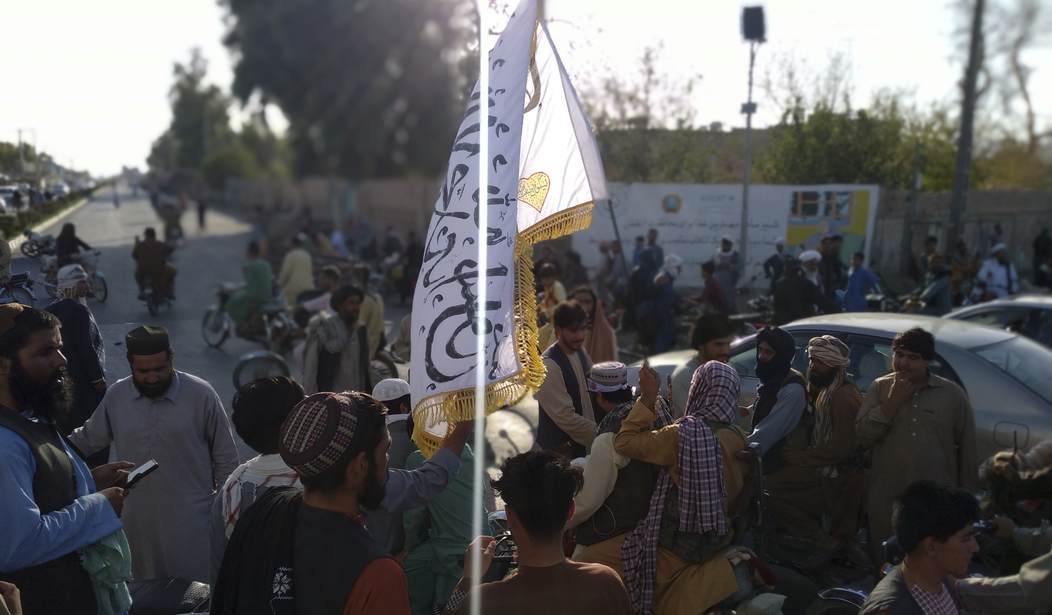Just five days ago, Joe Biden told the media, “I do not regret my decision” to summarily withdraw U.S. forces from Afghanistan with no plan in place to stabilize the country’s government.
That government is collapsing. Afghan President Ashraf Ghani has reportedly fled the country as the Taliban moves into Kabul and awaits a “transfer of power.”
Another word for “transfer” is “surrender.” The Taliban has the momentum and will wait — but likely not for long — before resuming its military campaign to destroy the Afghan government. One question now is whether the United States will be able to remove its own embassy personnel from Kabul. On Saturday, the Biden administration increased the military deployment to Afghanistan to 5,000 for that evacuation. The American force will find itself surrounded by enemies, both Taliban and those Afghan forces who now are likely either melting away or actively switching sides.
Asked about Afghanistan’s meltdown last week, White House spokeswoman Jen Psaki said, “The Taliban also has to make an assessment about what they want their role to be in the international community.”
The Taliban made that assessment when it succored al Qaeda as it planned the September 11, 2001, attacks on the United States. Its ideology is 1,400 years old and has not changed in the 20 years of warfare in Afghanistan.
Unfortunately, Psaki’s perspective is also that of her boss and the entire U.S. administration and military-diplomatic establishment.
The Taliban is reportedly seizing much of the equipment that the U.S. donated to the Afghan military over the years, including drones, giving the Taliban at least a rudimentary air force to go along with its fast-moving ground forces.
Psaki was asked about this during the same briefing.
“Are you aware of any safeguards for American materiel that may fall into the Taliban hands if they continue to take over more land in Afghanistan?” a reporter asked.
“Well, we certainly take that risk seriously,” Psaki replied. “It is a concern of ours, as it would be in any warzone where we provide assistance. We did take steps to retrograde some of the equipment over the past several months in preparation for that possibility. But we do take that seriously; we watch it closely, as well.”
That’s not much of an answer. Defense World reported last week that the Taliban was capturing American ScanEagle drones and at least one Indian helicopter.
Afghanistan has many of these UAVs in its inventory. The latest FMS order for 15 ScanEagles for the country was placed in November 2020. An initial order for 65 UAVs was placed in 2015 for $70.9 million, followed by subsequent orders for five in 2017 and 35 in 2018.
The ScanEagle UAV is 5.1 feet long with a 5.6-foot wingspan. It weighs as much as 48.5 pounds and can carry a 7.5-pound sensor payload. The UAV can fly for more than 24 hours at altitudes as high as 19.500 feet, and at speeds to 80 knots.
The drones are not all the Taliban have snapped up. They reportedly picked up ground gear that they then deployed to speed their advance on Kabul.
Video also shows scores of US-made Humvees and other armoured vehicles captured by the militants, which they have already put to use in their lightning advance.
Afghans have already had a taste of Taliban brutality with reports emerging that they “going to door to door” to round up young girls to be “sex slaves” for the terror group.
Afghanistan’s ambassador to the US said terrified Kabul residents were preparing for the worst and a last stand.
Whether he regrets his decision or not, whether it was even his decision at all, the meltdown of Afghanistan is Joe Biden’s debacle. He inherited an Afghanistan that was quiescent by its standards. He announced a withdrawal pegged to 9-11 with no plan, similar to his handling of Iraq as vice president, which led to the rise of ISIS. Afghanistan is falling to the Taliban now, and will become a jihadist base of operations and probably a Chinese vassal state in short order. Or, should India see its interests threatened, Afghanistan could become the nexus of a new land war directly or by proxy in Asia. There are no likely outcomes for Afghanistan now that do not involve extremism, oppression, warfare, and threats to the region and the world, including the United States. None.
More: Fox reports the first Biden administration reaction to the news that Afghanistan’s president has fled.
“That’s it. It’s over,” a U.S. official said.
The official is wrong. The fall of Kabul is just the beginning of the horrific fallout from Biden’s decisions.









Join the conversation as a VIP Member